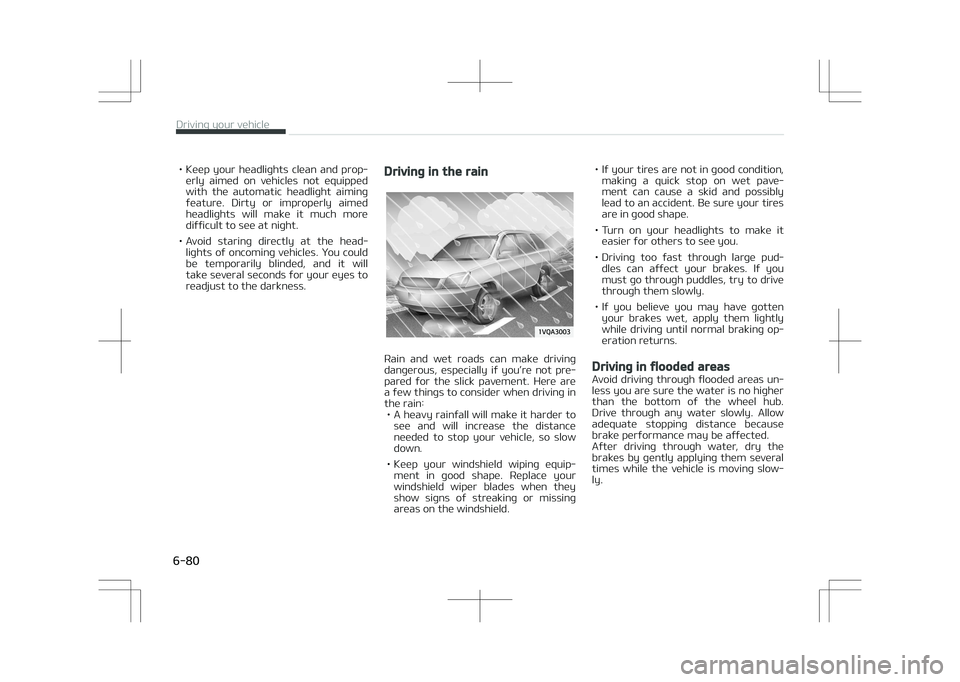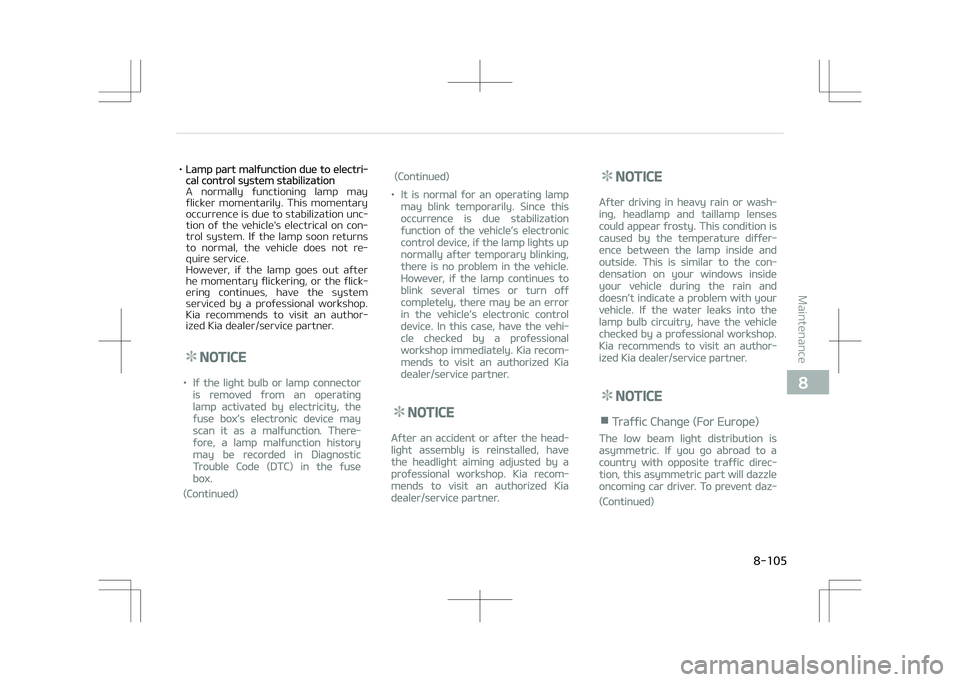headlight aiming KIA STONIC 2018 Owners Manual
[x] Cancel search | Manufacturer: KIA, Model Year: 2018, Model line: STONIC, Model: KIA STONIC 2018Pages: 523, PDF Size: 24.99 MB
Page 302 of 523

• Keep your headlights clean and prop‐erly aimed on vehicles not equipped
with the automatic headlight aiming feature. Dirty or improperly aimed
headlights will make it much more
difficult to see at night.
• Avoid staring directly at the head‐ lights of oncoming vehicles. You could
be temporarily blinded, and it will take several seconds for your eyes to
readjust to the darkness.Driving in the rain
Rain and wet roads can make driving
dangerous, especially if you’re not pre‐ pared for the slick pavement. Here are
a few things to consider when driving in
the rain: • A heavy rainfall will make it harder to see and will increase the distanceneeded to stop your vehicle, so slow
down.
• Keep your windshield wiping equip‐ ment in good shape. Replace your
windshield wiper blades when they show signs of streaking or missing
areas on the windshield. • If your tires are not in good condition,
making a quick stop on wet pave‐
ment can cause a skid and possibly
lead to an accident. Be sure your tires are in good shape.
• Turn on your headlights to make it easier for others to see you.
• Driving too fast through large pud‐ dles can affect your brakes. If you
must go through puddles, try to drive
through them slowly.
• If you believe you may have gotten your brakes wet, apply them lightly
while driving until normal braking op‐
eration returns.Driving in flooded areas
Avoid driving through flooded areas un‐
less you are sure the water is no higher than the bottom of the wheel hub.
Drive through any water slowly. Allow
adequate stopping distance because brake performance may be affected.
After driving through water, dry the
brakes by gently applying them several
times while the vehicle is moving slow‐ ly.
Driving your vehicle
6-80
Page 451 of 523

•Lamp part malfunction due to electri‐cal control system stabilization
A normally functioning lamp may
flicker momentarily. This momentary occurrence is due to stabilization unc‐
tion of the vehicle's electrical on con‐
trol system. If the lamp soon returns
to normal, the vehicle does not re‐
quire service.
However, if the lamp goes out after he momentary flickering, or the flick‐
ering continues, have the system
serviced by a professional workshop.
Kia recommends to visit an author‐
ized Kia dealer/service partner.
NOTICE
•If the light bulb or lamp connector
is removed from an operating
lamp activated by electricity, the
fuse box’s electronic device may
scan it as a malfunction. There‐
fore, a lamp malfunction history
may be recorded in Diagnostic
Trouble Code (DTC) in the fuse
box.
(Continued)
(Continued)
•It is normal for an operating lamp
may blink temporarily. Since this
occurrence is due stabilization
function of the vehicle’s electronic
control device, if the lamp lights up
normally after temporary blinking,
there is no problem in the vehicle.
However, if the lamp continues to
blink several times or turn off
completely, there may be an error
in the vehicle’s electronic control
device. In this case, have the vehi‐
cle checked by a professional
workshop immediately. Kia recom‐
mends to visit an authorized Kia
dealer/service partner.
NOTICE
After an accident or after the head‐
light assembly is reinstalled, have
the headlight aiming adjusted by a
professional workshop. Kia recom‐
mends to visit an authorized Kia
dealer/service partner.
NOTICE
After driving in heavy rain or wash‐
ing, headlamp and taillamp lenses
could appear frosty. This condition is
caused by the temperature differ‐
ence between the lamp inside and
outside. This is similar to the con‐
densation on your windows inside
your vehicle during the rain and
doesn’t indicate a problem with your
vehicle. If the water leaks into the
lamp bulb circuitry, have the vehicle
checked by a professional workshop.
Kia recommends to visit an author‐
ized Kia dealer/service partner.
NOTICE
nTraffic Change (For Europe)
The low beam light distribution is
asymmetric. If you go abroad to a
country with opposite traffic direc‐
tion, this asymmetric part will dazzle
oncoming car driver. To prevent daz‐
(Continued)
8-105
8
Maintenance